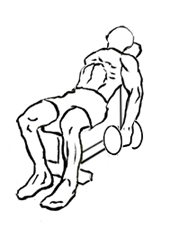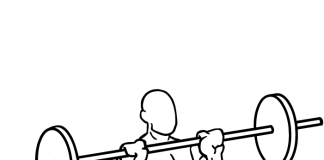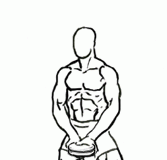Last Updated on September 30, 2022
The Incline Inner Biceps Curl with Dumbbell is an effective exercise for targeting the biceps and achieving maximum muscle engagement. By positioning the body at an incline, this exercise shifts the emphasis onto the inner portion of the biceps, making it perfect for those looking to build arm strength and shape. This comprehensive guide covers everything you need to know about the Incline Inner Biceps Curl, including benefits, proper form, variations, and tips to optimize your results.
What is the Incline Inner Biceps Curl with Dumbbell?
The Incline Inner Biceps Curl is a variation of the classic biceps curl performed on an incline bench. The incline position stretches the biceps and allows for a longer range of motion, providing a deeper muscle contraction compared to traditional standing curls. This exercise is ideal for isolating the biceps and working on muscle definition and peak.
Muscles Worked:
- Biceps Brachii (Long Head): The primary target muscle, specifically the inner portion.
- Brachialis: Assists in the curling motion, contributing to overall arm strength.
- Forearms: Stabilizer muscles that support the movement, especially as you grip the dumbbells.
Benefits of the Incline Inner Biceps Curl
- Maximizes Biceps Isolation:
- The incline position and inner curl motion isolate the biceps, focusing on the long head, which helps build arm size and peak.
- Increased Range of Motion:
- By using an incline bench, this exercise provides a deeper stretch and fuller contraction, enhancing muscle activation and growth.
- Reduced Momentum:
- Unlike standing curls, the inclined position reduces the risk of swinging or using momentum, ensuring that the biceps do all the work. This leads to more efficient muscle engagement.
- Improved Mind-Muscle Connection:
- The slow, controlled nature of the incline inner curl allows lifters to focus on the movement, enhancing the mind-muscle connection and optimizing bicep activation.
- Versatility for All Levels:
- Whether you’re a beginner looking to build foundational strength or an advanced lifter aiming for sculpted arms, the incline inner biceps curl can be tailored to suit all fitness levels.
How to Perform the Incline Inner Biceps Curl Properly
Step-by-Step Guide:
- Set Up the Bench:
- Adjust the incline bench to a 45-degree angle. This angle maximizes the stretch in the biceps without shifting too much focus onto the shoulders.
- Position Yourself Correctly:
- Sit back on the bench with your feet flat on the floor for stability. Allow your arms to hang down fully, with your palms facing your body. This starting position helps lengthen the biceps for maximum contraction during the lift.
- Grip the Dumbbells:
- Hold a dumbbell in each hand with an underhand grip (palms facing your body). Keep your back and shoulders firmly against the bench.
- Curl the Dumbbells:
- Keeping your elbows close to your body and stationary, curl the dumbbells upward in a controlled manner. Rotate your palms as you lift so that they face inward by the top of the movement, emphasizing the inner biceps.
- Focus on the Squeeze:
- As you reach the top of the curl, squeeze your biceps for a second to maximize contraction.
- Control the Descent:
- Slowly lower the dumbbells back down to the starting position, maintaining tension in your biceps throughout the movement. Avoid letting your arms sway or your back lift off the bench.
- Repeat for Reps:
- Aim for 3–4 sets of 8–12 reps, ensuring each repetition is slow and controlled to fully engage the biceps.
Common Mistakes to Avoid
Even though the incline inner biceps curl is a straightforward exercise, several common mistakes can reduce its effectiveness or increase injury risk:
- Using Too Much Weight:
- It’s tempting to lift heavier weights, but doing so often leads to compromised form. Start with a manageable weight to maintain control throughout the movement.
- Lifting with Momentum:
- Avoid using your shoulders or back to lift the dumbbells. The movement should be slow, allowing the biceps to do all the work.
- Locking the Elbows:
- Keep a slight bend in your elbows at the bottom of the movement to protect your joints and maintain tension in the biceps.
- Arching Your Back:
- Ensure that your back remains flat against the bench throughout the exercise. Arching your back can reduce bicep engagement and increase the risk of injury.
- Inconsistent Range of Motion:
- Some people fail to fully extend their arms at the bottom of the curl, reducing the effectiveness of the exercise. Focus on lowering the dumbbells in a controlled manner for a complete stretch.
Variations of the Incline Inner Biceps Curl
To keep your workout dynamic and target different parts of the biceps, you can incorporate several variations:
- Single-Arm Incline Inner Biceps Curl:
- Perform the curl with one arm at a time, enhancing the mind-muscle connection and allowing for greater focus on each bicep individually.
- Incline Hammer Curl:
- Instead of rotating your palms inward, keep them facing each other throughout the motion. This variation engages the brachialis and forearms more, adding strength and thickness to the upper arm.
- Incline Cable Curl:
- Use a cable machine instead of dumbbells for constant tension throughout the range of motion. This variation increases bicep activation, especially at the peak of the curl.
- Reverse Incline Inner Curl:
- Perform the curl with an overhand grip, focusing on the brachialis and forearms. This variation adds variety to your routine and promotes balanced arm development.
- Incline Curl with Twist:
- Twist the dumbbells as you reach the top of the curl, turning your palms outward. This enhances the peak contraction and helps define the inner biceps.
Tips for Maximizing Your Incline Inner Biceps Curl
- Warm-Up Thoroughly:
- Before performing the curl, warm up with light dynamic stretches and mobility work for the arms and shoulders to prepare your muscles and joints.
- Engage the Core:
- Tightening your core stabilizes your body and prevents your back from arching, allowing your biceps to work more efficiently.
- Focus on the Eccentric Phase:
- Slowing down the lowering phase (eccentric phase) of the curl increases time under tension, promoting muscle growth. Take 3-4 seconds to lower the weights.
- Mind-Muscle Connection:
- Visualize the biceps contracting as you lift and lower the weights. Concentrating on the movement enhances muscle activation and results.
- Implement Progressive Overload:
- To build muscle, gradually increase the weight, reps, or sets over time. Track your progress and challenge yourself regularly.
Incline Inner Biceps Curl vs. Other Biceps Exercises
Comparing this exercise with other bicep curls can help you build a balanced arm routine:
- Standing Dumbbell Curl: While effective, this variation often allows for more momentum, reducing bicep isolation. The incline version prevents swinging, ensuring the biceps remain the focus.
- Preacher Curl: Like the incline curl, the preacher curl isolates the biceps but uses a different angle. Incorporating both ensures varied stimulation for balanced development.
- Concentration Curl: Another isolation exercise, but the incline curl offers a greater range of motion, making it more effective for bicep lengthening and peak.
The Science Behind Incline Inner Biceps Curl
By adjusting the angle of the bench, the biceps are stretched more than in standing or seated curls, which lengthens the muscle fibers. This positioning increases the range of motion, allowing for a fuller contraction. Research shows that varying angles in biceps training maximizes muscle growth by targeting different parts of the muscle group. The incline inner biceps curl emphasizes the long head of the biceps, which helps build arm peak and size.
Nutrition and Recovery for Bicep Growth
Combining incline inner biceps curls with a proper diet and recovery routine is key:
- Protein Intake: Consume 1.6–2.2 grams per kilogram of body weight daily to support muscle repair and growth.
- Carbohydrates: Fuel your workouts with complex carbs like oats, brown rice, and sweet potatoes to maintain energy levels and support muscle recovery.
- Hydration: Drink plenty of water to keep muscles hydrated, aiding in performance and recovery.
- Sleep: Prioritize 7–9 hours of sleep each night to allow your biceps and other muscle groups to recover and grow.
Integrating the Incline Inner Biceps Curl into Your Workout Routine
To fully benefit from the incline inner biceps curl, it’s essential to integrate it into your arm workout effectively. Here’s a sample biceps-focused workout routine:
- Warm-Up:
- Start with dynamic stretches (5–10 minutes), focusing on the arms and shoulders to increase blood flow and prepare the muscles for lifting.
- Perform light resistance band curls (2 sets of 12 reps) to activate the biceps and get the joints ready.
- Compound Movement:
- Begin your arm workout with a compound biceps movement like the Barbell Curl (4 sets of 8–10 reps) to build overall strength.
- Incline Inner Biceps Curl:
- Follow up with the Incline Inner Biceps Curl (3–4 sets of 10–12 reps). Focus on form, range of motion, and the mind-muscle connection to maximize biceps isolation.
- Hammer Curls:
- Perform Hammer Curls (3 sets of 10–12 reps) to engage the brachialis and build upper arm thickness.
- Concentration Curls:
- Finish with Concentration Curls (3 sets of 12–15 reps per arm) to further isolate the biceps and target muscle peak.
- Cool Down:
- Conclude your workout with static stretches for the biceps, shoulders, and forearms (5–10 minutes) to promote flexibility and recovery.
Frequently Asked Questions About Incline Inner Biceps Curl
1. What is the optimal angle for the incline bench?
- The best angle for this exercise is between 30 and 45 degrees. An angle lower than 30 degrees may not provide enough stretch, while an angle higher than 45 degrees can place undue emphasis on the shoulders.
2. How much weight should I start with?
- Begin with a light to moderate weight that allows you to complete 10–12 reps with proper form. As you gain strength, gradually increase the weight while maintaining control throughout the movement.
3. How does the incline inner biceps curl differ from other curls?
- The incline inner biceps curl emphasizes the long head of the biceps and allows for a greater range of motion than standing or seated curls. This variation enhances muscle isolation and development, focusing on the biceps peak.
4. Can I perform this exercise with cables instead of dumbbells?
- Yes, using a cable machine provides constant tension throughout the range of motion, which can further enhance muscle activation. Make sure the cable height aligns with the incline angle of the bench to replicate the dumbbell motion accurately.
5. How often should I do incline inner biceps curls?
- Incorporate this exercise into your routine 1–2 times per week, ensuring at least 48 hours of recovery between sessions. This allows your biceps to recover and grow effectively.
Advanced Tips for Incline Inner Biceps Curl
- Eccentric Focus:
- Slow down the lowering phase (eccentric phase) of the curl to increase time under tension. This strategy stimulates muscle growth and strength gains by emphasizing the controlled descent.
- Superset for Maximum Pump:
- Superset the incline inner biceps curl with a compound movement like chin-ups or hammer curls to exhaust the biceps fully and maximize hypertrophy.
- Progressive Overload:
- Keep track of your progress by gradually increasing the weight or reps. Progressive overload is crucial for muscle growth, but always prioritize form to avoid injury.
- Mind-Muscle Connection:
- Visualize the biceps contracting as you curl the weights up and focus on squeezing the muscle at the top of the movement. This enhances muscle activation and helps achieve better results.
- Incorporate Drop Sets:
- After reaching failure with your working weight, immediately drop to a lighter weight and continue performing reps until failure again. This technique pushes your biceps beyond their limits, promoting growth and strength gains.
The Science Behind the Incline Inner Biceps Curl
The incline position stretches the long head of the biceps, emphasizing the lower portion and promoting full range of motion. Research shows that varying the angle of exercises can lead to greater overall muscle development by targeting different fibers within the muscle. Incline curls activate the muscle fibers from a different angle than traditional curls, resulting in enhanced muscle peak and size.
By combining the benefits of the incline bench and the inner curl movement, this exercise promotes optimal muscle activation, contributing to more balanced arm development and strength gains over time.
Final Thoughts
The Incline Inner Biceps Curl with Dumbbell is a versatile and effective exercise for anyone serious about building strong, defined biceps. Its emphasis on the long head of the biceps helps enhance the muscle’s shape and peak, contributing to a fuller, more muscular arm appearance. Whether you’re a beginner or an advanced lifter, incorporating this exercise into your routine can provide new stimulus for growth and strength development.
For the best results, ensure you focus on form, maintain controlled movements, and gradually increase intensity through progressive overload. Pair the incline inner biceps curl with other bicep exercises like hammer curls, concentration curls, and barbell curls for a comprehensive arm workout. Combined with proper nutrition and recovery, this exercise can transform your biceps and take your upper body training to the next level.








